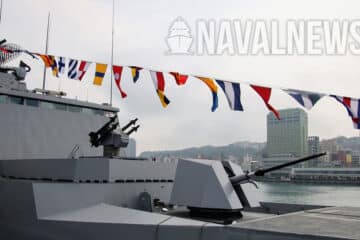Military analyst Guy Plopsky was at the event and share his pictures with us. All three projects were showcased by Taiwan’s naval shipbuilder: China Shipbuilding Corporation (CSBC).
ROC Navy Landing Platorm Dock (LPD)
CSBC’s LPD features a modern design, with two enclosed masts which appear similar in concept to the Advanced Enclosed Mast/Sensors (AEM/S) found aboard the San Antonio-class (LPD 17) of the U.S. Navy.
The scale model shows a 76mm main gun at the bow, two PHALANX CIWS (one forward, one aft on top the hangar) and probably the most unique feature for this future class of ship (and likely a first for an amphibious transport dock): 2×4 missile launchers amidship, likely for Hsiung Feng II and III anti-ship missiles.

The design, based on the sale model, also features a large helicopter deck, two hangar doors, two shaft lines and of course a well deck.
According to Jane’s, the LPD will have an overall length of 153 meters, an overall beam of 23 meters, and a hull draught of 6 meters. CSBC received a contract for the vessel, which has been ordered to fulfil the ROC Navy amphibious assault requirements, in April 2018. A total of four units are expected to be produced.
While these four ships will likely be replacing the two outdated Newport-class LST (ROCS Chung Ho and ROCS Chung Ping) and the single Anchore-class LSD (ROCS Hsu Hai), they will represent a huge capability increase. It is not clear where the new LPDs will fit in the ROC Navy doctrine, which is focused on defending against large scale (amphibious) assault from mainland China. The LPDs are, by nature, assault ships. They could potentially be used to project power/deploy forces on Penghu islands in the strait.
ROC Navy High-speed Mine Laying Ship
ROC Navy begun the development of this high speed mine layer in 2014. The design is focusing on reduced manpower, high payload and high speed (to reach the area of operation in short time).
The vessel is fitted with an automatic mine laying system to increase operational efficiency. It has a length of 41 meters and a beam of 8.8 meters.

Four vessels (known as the Min Jiang-class) are on order with the Lung Teh Shipbuilding Co. The first is set to be commissioned with the ROC Navy by 2021.
ROC Navy Flight II Tuo Chiang-class
According to a poster at the show, the Flight II Tuo Chiang-class corvette is based on the (sole) existing Tuo Chiang-class corvette fitted with “latest technologies to improve both its platform and combat systems”.
On December 4, 2018, Taiwanese media confirmed that Lung Teh Shipbuilding won a tender for the construction of 11 improved corvettes. Taiwanese media have dubbed these catamaran corvettes as “aircraft carrier killers”, referencing to the PLA Navy growing carrier force. They have a length of 65 meters and a displacement of 680 tonnes (compared to 560 tons for the existing Flight I). Their top speed is 45 knots.
They are fitted with eight subsonic Hsiung Feng-II and eight supersonic Hisung Feng-III anti-ship missiles. They may also be fitted with HC-2 SAM (in top side launchers), presumably in place of some of the anti-ship missile launchers.
The flight II is rumored to be able to deploy sea mines as well. Images (including below) show the vessel fitted with rails at the stern.

A keel laying ceremony was held at the Lung Teh Shipbuilding Co. on May 24, 2019 for three of these Flight II vessels. The first of three corvettes should be introduced into the Taiwanese fleet by 2025.
ROC Navy Destroyer project
Unfortunately, the destroyer (DDG) and domestic submarine (SSK) project and scale models were not on display this year…







One Comment
Pingback : Taiwan Launched a 600 Tons Coast Guard Cataraman That Can Fire 16 ASM - Naval News